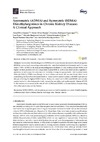Please use this identifier to cite or link to this item:
http://hdl.handle.net/10553/70004
| Title: | Asymmetric (ADMA) and symmetric (SDMA) dimethylarginines in chronic kidney disease: A clinical approach | Authors: | Oliva-Damaso, Elena Oliva-Damaso, Nestor Rodríguez Esparragón, Francisco Javier Payan, Juan Baamonde-Laborda, Eduardo Gonzalez-Cabrera, Fayna Santana-Estupiñan, Raquel Rodríguez Pérez, José Carlos |
UNESCO Clasification: | 32 Ciencias médicas | Keywords: | ADMA Asymmetric Dimethylarginine Cardiovascular Chronic Kidney Disease End-Stage Renal Disease, et al |
Issue Date: | 2019 | Journal: | International Journal of Molecular Sciences | Abstract: | Asymmetric dimethylarginine (ADMA) and its enantiomer, Symmetric dimethylarginine (SDMA), are naturally occurring amino acids that were first isolated and characterized in human urine in 1970. ADMA is the most potent endogenous inhibitor of nitric oxide synthase (NOS), with higher levels in patients with end-stage renal disease (ESRD). ADMA has shown to be a significant predictor of cardiovascular outcome and mortality among dialysis patients. On the other hand, although initially SDMA was thought to be an innocuous molecule, we now know that it is an outstanding marker of renal function both in human and in animal models, with ESRD patients on dialysis showing the highest SDMA levels. Today, we know that ADMA and SDMA are not only uremic toxins but also independent risk markers for mortality and cardiovascular disease (CVD). In this review, we summarize the role of both ADMA and SDMA in chronic kidney disease along with other cardiovascular risk factors. | URI: | http://hdl.handle.net/10553/70004 | ISSN: | 1422-0067 | DOI: | 10.3390/ijms20153668 | Source: | International Journal of Molecular Sciences [ISSN 1422-0067], v. 20 (15), 3668, (Agosto 2019) |
| Appears in Collections: | Artículos |
SCOPUSTM
Citations
89
checked on Mar 30, 2025
WEB OF SCIENCETM
Citations
83
checked on Mar 30, 2025
Page view(s)
153
checked on Dec 21, 2024
Download(s)
294
checked on Dec 21, 2024
Google ScholarTM
Check
Altmetric
Share
Export metadata
Items in accedaCRIS are protected by copyright, with all rights reserved, unless otherwise indicated.
